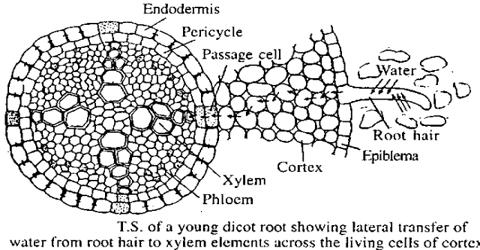Active absorption: Metabolic energy is required in this process. In fact, the absorption in this process takes place by osmosis.
Aikens (1916) and Priestly (1921) mentioned about the role of osmosis in the process of absorption by root hairs According to them, absorption takes place due to the variation of osmotic pressure (O.P.) in between the capillary water and the root hair sap.
The process of Active absorption:
As the O.P. of the root hair sap is greater than the O. P. of capillary water, so the capillary water enters the root hairs. This water gradually reduces the concentration of the root hair sap. Water is absorbed due to activities going on in roots. Absorption of water occurs with the help of energy in the form of ATP, which is released due to metabolic activities of root cells such as respiration. Absorption takes place against concentration gradient – even when the concentration of cell sap is lower than that of soil water.
Following cell to cell Osmosis, water from the root hair reaches up to the endodermis passing through epidermal cells. Now, the flows of water occur through passage cells of the endodermis.
In this process, the cortex cells become turgid at one time by absorbing water and they again become flaccid when then water is transferred to the adjacent cells. These flaccid cells again become turgid by absorbing water. A pressure produced in the cells by gradually being flaccid and turgid due to osmosis is called Root pressure (R.P.). The water absorbed by osmosis enters the xylem vessels and from xylem vessels, it reaches the leaf by root pressure (R.P).















